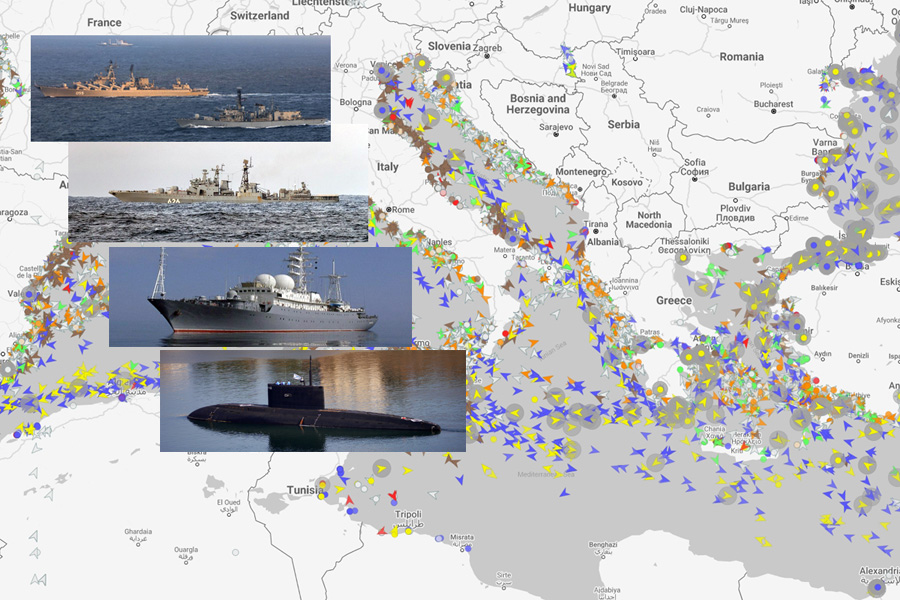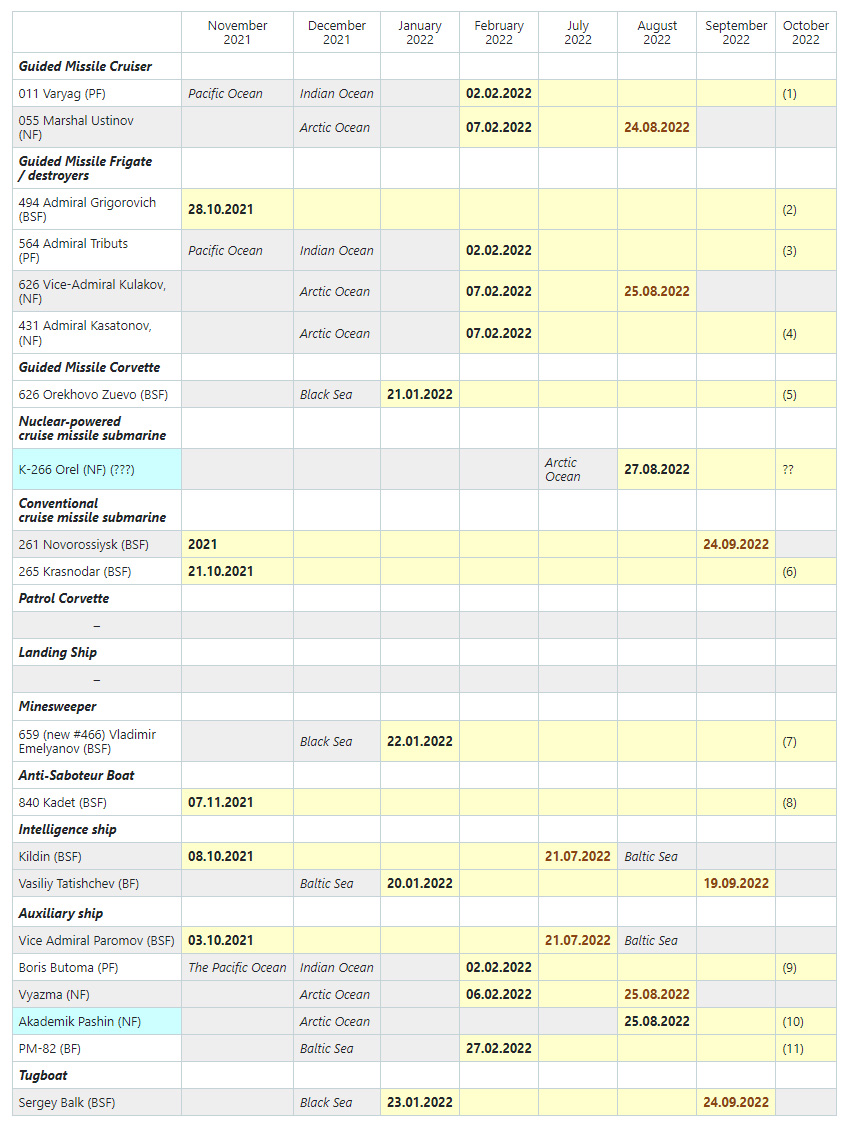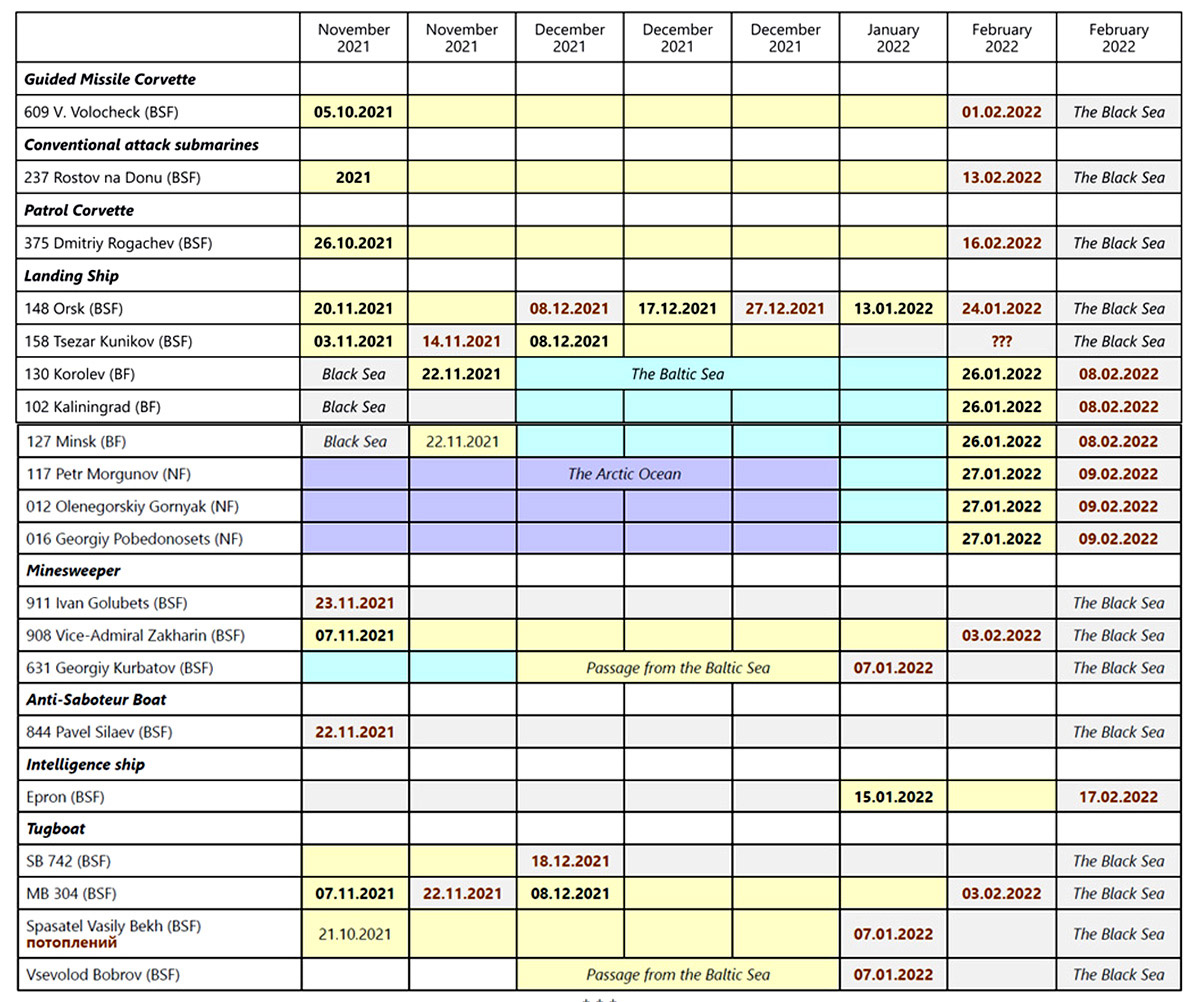The Presence of Russian Warships in the Mediterranean Sea as of 10 October 2022

The Monitoring Group of BlackSeaNews
and the Black Sea Institute of Strategic Studies
Summary
As we have forecasted earlier, the RF continues to reduce its naval presence in the Mediterranean, namely:
- On September 19, 2022, the Baltic Fleet reconnaissance ship Vasiliy Tatishchev left the Mediterranean Sea via Gibraltar.
- On September 24, 2022, the Black Sea Fleet missile submarine Novorossiysk accompanied by the Sergey Balk tug left the Mediterranean Sea via Gibraltar.
In late summer of 2022, Russia began the rotation of part of its warships in the Mediterranean Sea. Namely, 2 missile ships of the Northern Fleet, a reconnaissance ship of the Black Sea Fleet, 2 oil tankers of the Black Sea and Northern Fleets were withdrawn from the Mediterranean Sea - a total of 5 ships.
At the same time, an oil tanker of the Northern Fleet arrived in the Mediterranean Sea. In addition, it is not excluded that in early September 2022, Russia could have deployed a nuclear or diesel submarine carrying cruise missiles into the Mediterranean Sea without official publicity.
It is worth reminding that as of 27 February 2022, Russia’s squadron of 13 ships and 5 auxiliary vessels of the four Russian fleets was in the Mediterranean Sea, including 9 attack missile ships: 2 missile cruisers, 4 guided-missile frigates and missile destroyers, 1 missile corvette, and 2 missile submarines.
As of 10 October 2022, the confirmed composition of the Russian Navy squadron in the Mediterranean Sea includes 8 ships (6 of which are missile ships) and 3 auxiliary vessels.
We can predict that in the near future the Russian Navy will continue the rotation of its other ships in the Mediterranean Sea.
This is due to the fact that because of Turkey's ban on the passage of Russian warships through the Dardanelles and Bosphorus Straits - including the passage of Black Sea Fleet ships to their home bases in the Black Sea - and Turkey's closure of the airspace for Russian military and civilian aircraft heading to Syria, the Russian squadron in the Mediterranean got "stuck.”
The impossibility of repairing and servicing Russian ships in the European ports of the Mediterranean countries against the backdrop of a weak repair base at the Russian Navy’s base in the Syrian port of Tartus will force Russia to return the ships of the Northern, Baltic, and Pacific fleets to their bases for repairs. Black Sea Fleet ships, which have been in the Mediterranean Sea for a long time, may also have to be redeployed to the Baltic Sea.
The full text of the report
As of 27 February 2022, Russia’s squadron of 13 ships and 5 auxiliary vessels of the four Russian fleets was in the Mediterranean Sea, including 9 attack missile ships: 2 missile cruisers, 4 guided-missile frigates and missile destroyers, 1 missile corvette, and 2 missile submarines (See Table 1).
This squadron, with an unchanged composition, was constantly in the Mediterranean Sea, based at the Russian naval base in the Syrian port of Tartus, until the end of July – beginning of September 2022.
The purposes of its formation were the following.
-
The replacement in the "Mediterranean squadron of the Russian Navy" of Russia’s Black Sea Fleet ships that had returned to the Black Sea a few weeks before the beginning of a large-scale war against Ukraine on 24 February 2022 (See Table 2).
-
Potential participation in the war against Ukraine in the Black Sea.
-
The demonstrative creation of a counterweight to the naval groups of NATO countries in the Mediterranean Sea.
As a result of Turkey's decision of 27 February 2022 to prohibit the passage of any Russian warships through the Bosphorus and Dardanelles - including Black Sea Fleet ships returning to their home bases in the Black Sea - the Russian squadron in the Mediterranean has de facto got "stuck." Its presence there has lost all meaning except the so-called "flag demonstration."
However, Russia continued to keep its naval group in the Mediterranean in conditions of limited traditional sea supplies from Black Sea bases and Turkey's closure of airspace for Russian military and civilian aircraft heading to Syria.
After 24 February 2022, the supply of the Mediterranean group of the Russian Navy by means of major amphibious ships from Russia’s ports on the Black Sea (the so-called "Syrian express"), as it traditionally happened, became impossible. Now civilian vessels - oil tankers and ro-ro ferries - are used for this purpose.
In addition, after the escalation of the war against Ukraine began on 24 February 2022, Russian warships lost the opportunity to carry out repairs in the ports of EU countries in the Mediterranean Sea, and the plans to transfer one of the floating docks from the Black Sea Fleet to Tartus in 2022 have not been implemented. The ship repair capabilities of the military floating workshop, which is permanently based in Tartus on a rotation basis, are limited, especially for large ships, most of which were built in Soviet times and require frequent repairs.
In late summer of 2022, the Russian Federation began withdrawing part of its ships from the Mediterranean Sea::
1. On 21 July 2022, Russia redeployed 2 ships of the Black Sea Fleet from the Mediterranean to the Baltic Sea - the reconnaissance ship Kildin (BSF) and the supply ship (oil tanker) Vice Admiral Paromov (BSF).
2. On 24-25 August 2022, Russia continued this process: namely, it withdrew 2 combat missile ships of the Northern Fleet from the Mediterranean Sea: the missile cruiser 055 Marshal Ustinov (NF) and the missile destroyer 626 Vice-Admiral Kulakov (NF). Together with them, the oil tanker of the Northern Fleet Vyazma (NF) left the Mediterranean Sea.
3. On September 19, 2022, the Baltic Fleet reconnaissance ship Vasiliy Tatishchev (402) left the Mediterranean Sea via Gibraltar
4. On September 24, 2022, the Black Sea Fleet missile submarine Novorossiysk accompanied by the Sergey Balk tug left the Mediterranean Sea via Gibraltar. Most probably, since the ships can’t return to the Black Sea due to Turkey’s closing of the straits, they are being redeployed to the Baltic Fleet.
The earlier information reported by Italian Internet resources that Russia could have quietly deployed a missile submarine in the Mediterranean Sea in early September 2022 remains unconfirmed.
Thus, as of 10 October 2022, the confirmed composition of the Russian Navy squadron in the Mediterranean Sea includes 8 ships (6 of which are missile ships) and 3 auxiliary vessels.
We maintain that in the near future the Russian Navy will continue the rotation of its other ships in the Mediterranean Sea.
* * *
The list of Russia’s missile warships in the Mediterranean Sea as of 10 October 2022:
-
The missile cruiser (011) Varyag, the flagship of the Pacific Fleet of the Russian Federation (PF), according to NATO classification - a missile cruiser Slava-class.
-
The missile frigate (494) Admiral Grigorovich, the Black Sea Fleet of the Russian Federation (BSF), a guided missile frigate, Krivak V-class.
-
The large anti-submarine ship (564) Admiral Tributs, the Pacific Fleet of the Russian Federation (PF), a guided-missile destroyer, Udaloy-class.
-
The missile frigate (431) Admiral Kasatonov, the Northern Fleet of the Russian Federation (NF), an Admiral Gorshkov class frigate.
-
The missile corvette (626) Orekhovo Zuevo, the Black Sea Fleet of the Russian Federation (BSF), a guided missile corvette, Buyan-M-class.
-
The missile submarine (265) Krasnodar, the Black Sea Fleet of the Russian Federation (BSF), a conventional attack submarine, Improved Kilo-class.
The presence of another missile submarine in the Mediterranean Sea requires official confirmation: either 266 Orel (a nuclear-powered cruise missile submarine (SSGN), project 949AM, Antey modernised, NATO codename Oscar II) of the Northern Fleet of the Russian Federation.
Table 1. The Presence of Warships of the Black Sea Fleet and Other Fleets of the Russian Federation in the Mediterranean Sea as of 14 September 2022
- The yellow colour of the cell - presence in the Mediterranean Sea.
- The blue colour of the cell - the ships that arrived in the Mediterranean Sea in August 2022.
- Black font - the date of arrival in the Mediterranean Sea.
- Red font - the date of leaving the Mediterranean Sea.
- PF - the Pacific Fleet of the Russian Federation.
- NF - the Northern Fleet of the Russian Federation.
- BSF - the Black Sea Fleet of the Russian Federation.
- BF - the Baltic Fleet of the Russian Federation

For reference:
The formation of a huge "Mediterranean squadron" of the Russian Navy in February 2022 from the Northern, Baltic, and Pacific Fleets’ ships allowed the Russian Black Sea Fleet to return a large number of ships to the Black Sea a few days (weeks) before Russia’s attack on Ukraine.
Among them, Russia redeployed 7 amphibious assault ships from the Mediterranean to the Black Sea, including 6 major amphibious assault ships of the Northern and Baltic Fleets.
Thus, by 24 February 2022, when the escalation of the war began, Russia had managed to form an unprecedented group of major amphibious assault ships in the Black Sea. Nominally, it consisted of 13 ships - 6 "guests" and 7 major amphibious assault ships of the Black Sea Fleet (one of them was under repair). Due to this, Russia got the opportunity to threaten with amphibious operations in the Black Sea and carry them out in the Sea of Azov.
However, the fact that Russia has failed to redeploy additional powerful missile surface combatants to the Black Sea called into question the effectiveness of a possible amphibious operation on the Ukrainian Black Sea coast. Currently, one of the major amphibious assault ships of the Black Sea Fleet has been sunk by the Ukrainian military, and 2 more have been seriously damaged and are undergoing long-term repairs/
Table 2. The Redeployment of Ships of the Black Sea Fleet and Other Fleets of the Russian Federation from the Mediterranean to the Black Sea at the End of 2021 - Beginning of 2022.

* * *
 This article has been prepared with the support of the European Union in Ukraine. The content of the article is the sole responsibility of the authors and does not necessarily reflect the position of the EU.
This article has been prepared with the support of the European Union in Ukraine. The content of the article is the sole responsibility of the authors and does not necessarily reflect the position of the EU.
More on the topic
- 04.11.2023 Deployment of Russian Warships in the Mediterranean as of November 1, 2023
- 31.05.2023 Deployment of Russian Warships in the Mediterranean as of May 31, 2023
- 06.11.2022 The presence of Russian warships in the Mediterranean Sea as of 6 November 2022
- 16.09.2022 The Presence of Russian Warships in the Mediterranean Sea as of 15 September 2022
- 11.05.2022 The Presence of Russian Warships in the Mediterranean Sea as of 10 May 2022
- 09.03.2022 The Presence of Russian Warships in the Mediterranean Sea as of 9 March 2022
- 15.02.2022 Increased Risks. Obstruction of Traffic in the Black and Azov Seas by Russia due to the Closure of Sea Areas for Military Exercises as of 15 February 2022
- 01.02.2022 The Presence of Russian Warships in the Black Sea and the Mediterranean Sea in January 2022
- 20.12.2021 International Security Risks in the Azov-Black Sea Region in November-December 2021